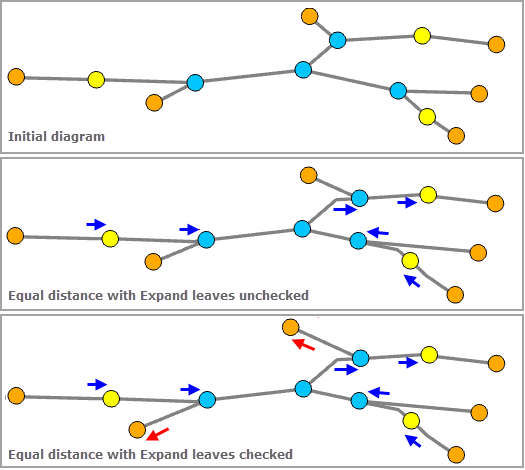Linear Dispatch  is a schematic layout algorithm that applies to any type of diagram.
is a schematic layout algorithm that applies to any type of diagram.
This layout algorithm also separates diagram edges connected to the target junctions. The valence for these junctions is taken into account—that is, the number of their adjacent edges as well as the edge paths can be preserved.
This layout algorithm is especially useful for water, wastewater, and gas, but can be deployed for other industries as well.
This layout algorithm adds space between diagram junctions that are visually too close, overlapping, or coincident. It moves junctions along their connected edges. The movement along the edges depends on the current and relative position of junctions and on the layout parameters.
The images below show a sample diagram before and after applying the Linear Dispatch layout: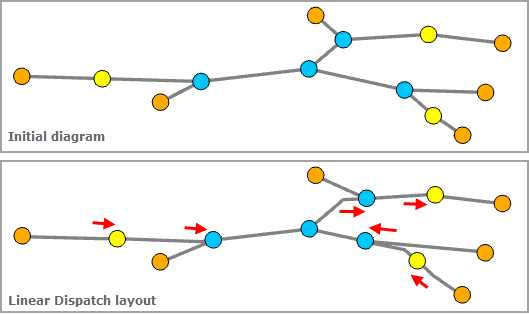
Apply the Linear Dispatch layout on an active diagram map view
When applying this layout on a network diagram, the following prerequisites must be met:
- Since this operation is transactional, edits must be saved before it is run.
- The input network diagram layer to which the layout applies must be from either a utility network or trace network in a file or mobile geodatabase, or a network diagram service. When working with a utility network or a trace network in an enterprise geodatabase, the input network diagram layer must be from a service.
To apply the Linear Dispatch layout on an active diagram map view, do one of the following:
- On the Network Diagram tab, click the drop-down arrow on the Diagram Layouts button in the Layout group, and click the Linear Dispatch
 layout item in the gallery.
layout item in the gallery. - Load the Apply Linear Dispatch Layout tool in the Geoprocessing pane, adjust the Linear Dispatch layout parameters and click Run.
Note:
To apply the layout algorithm on a subset of features in the network diagram, use one of the Select Features tools (for example, Select By Rectangle, Select By Polygon, and so on), and select the diagram features before running.
Configure the Linear Dispatch layout on a diagram template
To configure this layout on your diagram template, use the Add Linear Dispatch Layout tool.
Linear Dispatch layout parameters
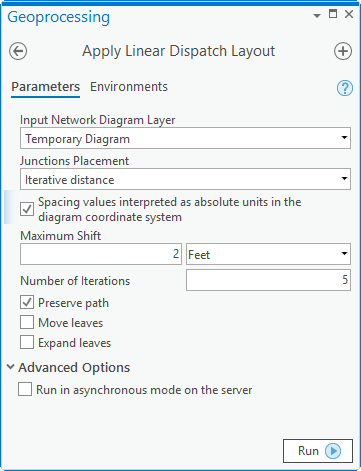
The sections below clarify the main Linear Dispatch diagram layout parameters.
Preserve container layout
Most of the layout algorithms work with the Preserve container layout option. When this option is checked, it allows you to control the algorithm application so it runs on the top graph of the diagram. When this option is not checked, the algorithm is applied to both content and noncontent features in the diagram.
Spacing values interpreted as absolute units in the diagram coordinate system
Some layout algorithms work with the Spacing values interpreted as absolute units in the diagram coordinate system option. This option specifies how the layout algorithm parameters representing distances will be interpreted:
- Checked—The layout algorithm will interpret any distance values as linear units.
- Unchecked—The layout algorithm will interpret any distance values as relative units to an estimation of the average of the junction sizes in the current diagram extent. This is the default.
Junctions Placement = Equal distance
When running Linear Dispatch with Junctions Placement = Equal distance, all junctions with two connected edges are moved so the distances between them and their two connected junctions are equal.
The images below show the equal distances computed to determine the locations of the three diagram junctions with two connections present in this sample diagram; those junctions are represented by a yellow circle: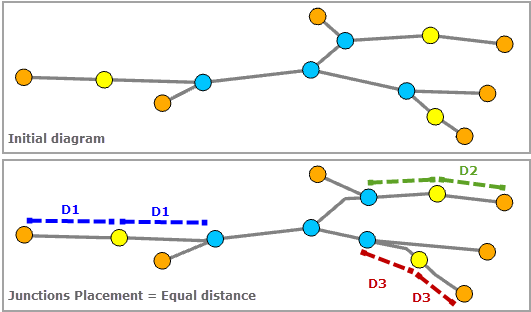
Junctions Placement = User define distance
When running Linear Dispatch with Junctions Placement = User define distance, all junctions with two connected edges are moved so there is a minimum distance between them and the other end of the edges to which they connect.
Minimum Shift
This parameter fixes the minimum distance that will separate junctions with two connected edges in the diagram after running the layout.
The images below show the Minimum Shift distance D used to compute the locations of the three diagram junctions with two connections present in this sample diagram; those junctions are represented by a yellow circle. Since the yellow junction at the bottom is already D distant from the orange leaf junction it is connected to, it is not moved. However, the other blue junction that it is connected to in the other direction is slightly moved so the minimum distance between it and that yellow junction is reached. The other two yellow junctions at the left and right sides of the diagram are moved along the diagram edges they connect to be minimum D distant from their two connected junctions:
Junctions Placement = Iterative distance
When running Linear Dispatch with Junctions Placement = Iterative distance, all junctions with two connected edges are moved slightly according to the Number of Iterations and Maximum Shift parameter values. The images below shows different layouts on a sample diagram after running Linear Dispatch with Iterative distance and applying a different number of iterations:
Number of Iterations
This parameter sets the number of iterations to process.
Maximum Shift
This parameter is used to specify the maximum distance the junctions with two connections will be spaced from the junctions to which they connect. At the time this distance is reached, junctions will not be moved during following iterations.
Preserve path
The Preserve path parameter specifies how vertices along edges will be processed:
- Checked—All vertices along the connected edges will be preserved, and new vertices will be added at the moved junctions' original locations.
- Unchecked—Vertices along the connected edges will be not preserved.
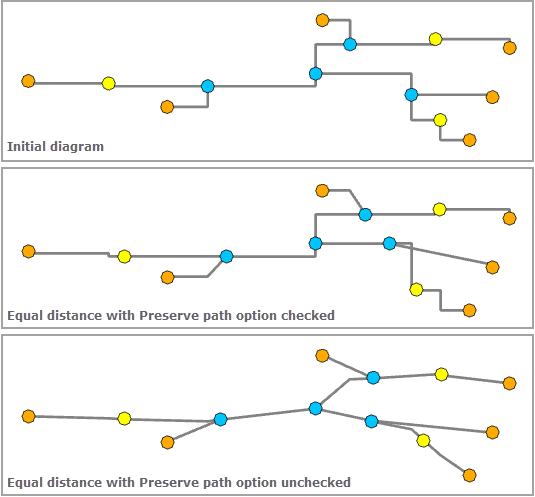
Move leaves
The Move leaves parameter specifies whether leaf junctions—junctions with one connection—will be moved during the algorithm process:
- Checked—Leaf junctions will be moved.
- Unchecked—Leaf junctions will not be moved.
The images below show the differences between these two processing modes. Without moving leaves, none of the orange leaf junctions are moved when the Linear Dispatch layout operates. When running the algorithm with the Move leaves option checked, three of the orange leaf junctions present in the diagram sustain a horizontal translation to follow the displacement of the blue junctions they are connected to and which are impacted by the linear dispatch process:
Expand leaves
The Expand leaves parameter specifies whether leaf junctions—junctions with one connection—will be expanded during the algorithm process:
- Checked—Leaf junctions will be expanded. The Maximum Expand Shift parameter value specifies the maximum distance the leaf junctions can be expanded from the junctions to which they connect.
- Unchecked—Leaf junctions will not be expanded.
The images below show the differences between these two processing modes. Without expanding leaves, none of the orange leaf junctions are expanded when the Linear Dispatch operates. When running the algorithm with the Expand leaves option checked, two of the orange leaf junctions present in the diagram that are connected to blue junctions impacted by the linear dispatch process are expanded. The third orange leaf junction that also connects to a blue junction is not moved because the distance between these two junctions is already greater than the specified Maximum Expand Shift parameter value.